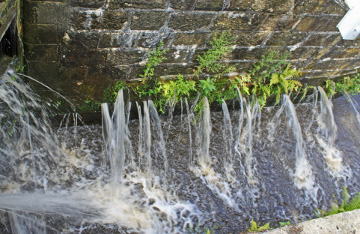THE catastrophic collapse of Lock 12 on the Aylesbury Arm of the Grand Union Canal will, as do all failures on the system, generate copious quantities of speculation as to what actually caused it, writes Maffi.
It may be difficult to determine exactly how this happened but you can be sure of this, many of the suggested reasons will be totally wrong!
I very much doubt Badgers, Rabbits, Water Voles or Crayfish caused it. I can't see ice being the culprit other than in causing the mortar to break up thereby letting in water to slowly erode the soil behind the walls.
Bollards
Recently I see there has been a new dairy built there and of course the surrounding soil was, not so long ago disturbed by the provisioning of the innocuous bollards, bollards that a lot of boaters agreed were a total waste of time and money. And if these turn out to be the cause there will be a lot of hand wringing and many "I told you so's." In all things speculative we will have to wait and see what the boy from Marks and Spencer's comes up with. Of course no one has yet suggested aliens, but I am sure they will.
I am reminded of an incident which happened at RAF Halton some years ago following the big storm in the 80s. Kermode Hall, the education block, had its roof borne rainfall piped off to a soak-away. At some time in its history a magnificent shrub was planted in the lawn beside the Hall. After the storm the shrub, which had been blown over, was removed.
The lawn was made good and no one thought anymore of it until about a year or so later the ground under that very spot collapsed leaving a 12 foot deep hole about 10 foot across which had been eroded by the rain water from the roof over 60 or 70 years. The roots of the shrub had held the topsoil together so forming a secure cap over the hole whilst the rain eroded away underneath.
Soil eroded
I feel sure that this is going on all over the system behind lock walls. It is my thinking that soil exerts little or no pressure on the lock walls. Once that soil is eroded, water in that space does press against the walls and puts undue pressure on the walls. From the constant filling and refilling of our locks the walls are possibly flexing in and out and over time this will cause failure.
A lot depends on the rate at which the soil is eroded and how big the space actually is. CaRT needs to find that out soonest. The next time this happens there may well be a boat in the lock and lives could be lost.
Napton Flight
Lock 10 on the Napton Flight has two small sink holes on the off side (about 4 x 4) the soil is cracked and, I think, slowly subsiding. CaRT is aware of this and I hope is preparing to fix it.
 There are many locks all over the system that have caverns, some small, some big; filled with water behind the walls. This water leaks out when the locks are emptied and seeps back in when they are refilled. Many of us have realized only too late that closing windows is a must in some of the leakier locks.
There are many locks all over the system that have caverns, some small, some big; filled with water behind the walls. This water leaks out when the locks are emptied and seeps back in when they are refilled. Many of us have realized only too late that closing windows is a must in some of the leakier locks.
Bosley Flight
Going up the Bosley Flight on the Macclesfield Canal, one of the locks spews water out of a crack in the fishtail wall before you even get into the lock. I have often thought that these ‘caverns' should be filled. Whether it is with mortar ot some synthetic substance I don't know, but now even more than before they should be filled. Until this is carried out we will all worry every time we lock through. Yes this may well be a one-off problem, but in our hearts we know it will happen again. It's just a matter of time.
